Are you looking for ways to make your garden more eco-friendly? Sustainable landscaping is a great way to create a beautiful and functional outdoor space while minimizing your environmental impact. By incorporating drought-tolerant plants into your landscape design, you can conserve water and save money on your water bill.
Drought-tolerant plants are species that have adapted to survive in low-water conditions. They require less watering than traditional garden plants, making them an ideal choice for sustainable landscaping. Not only do they reduce water usage, but they also require less maintenance and are often more resilient to pests and diseases.
Key Takeaways:
- Sustainable landscaping is an eco-friendly way to design your garden.
- Drought-tolerant plants require less water and are often easier to maintain.
- Incorporating these plants into your landscape design can help conserve water and reduce costs.
Creating a Water-Efficient Garden
Designing a water-efficient garden is an excellent way to conserve water and save money on your water bill. Xeriscaping, the practice of using plants that require little irrigation, is a popular and attractive option for creating a sustainable garden that can thrive in dry climates.
Here are some tips for designing a water-efficient garden:
Choose Native Plants
Native plants are adapted to local climate conditions and require less water and maintenance than exotic species. Research the native plants in your area and choose those that are drought-tolerant and appropriate for your soil type and sun exposure.
Group Plants by Water Needs
Grouping plants with similar water needs together can simplify irrigation and reduce water waste. Plants that require frequent watering should be located near a water source, while those that can tolerate drought should be placed in areas with less access to water.
Install a Drip Irrigation System
A drip irrigation system delivers water directly to the root zone of plants, reducing evaporation and water runoff. This system can be more efficient than sprinklers and can reduce water usage by up to 60%. It’s easy to install and can save you time and money in the long run.
Add Mulch
Mulch can help retain moisture in the soil, reduce weed growth, and regulate soil temperature. Covering the soil with a layer of organic mulch, such as wood chips or straw, can help reduce water loss and make your garden more sustainable.
Use Permeable Surfaces
Permeable surfaces, such as crushed stone or gravel, allow rainwater to infiltrate the soil instead of running off into storm drains. This can reduce erosion and prevent water pollution. Consider using permeable materials for walkways, patios, or parking areas in your garden.
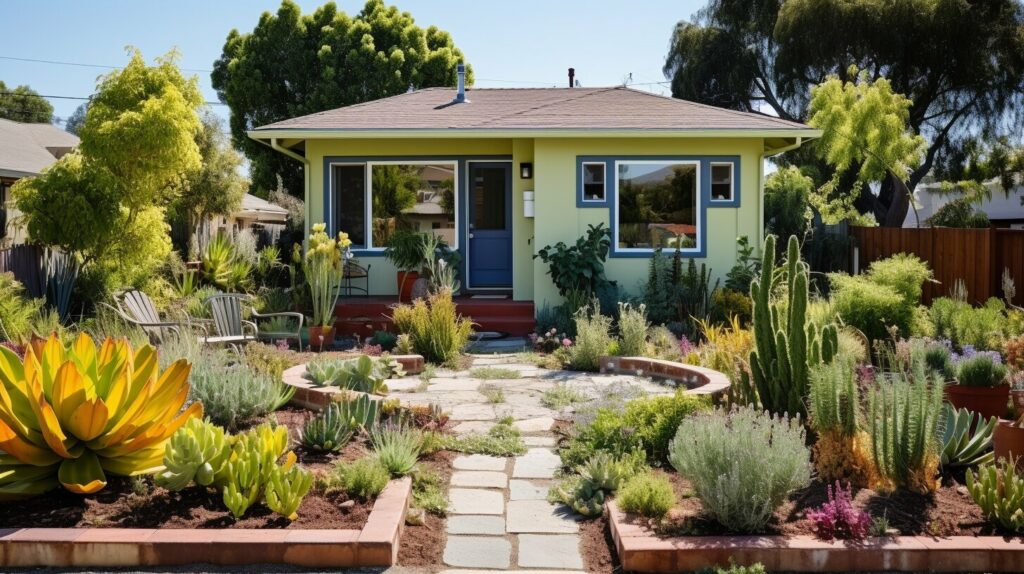
Creating a water-efficient garden can be fun and rewarding, and it’s an easy way to contribute to a more sustainable future. By using these simple techniques and strategies, you can create a beautiful garden that conserves water, reduces costs, and enhances the environment.
Choosing the Right Drought-Tolerant Plants
Choosing the right plants for your sustainable landscape is crucial for achieving a beautiful and low-maintenance garden. When selecting drought-tolerant plants, it’s essential to consider the specific conditions of your region and climate.
Native plants are an excellent option for sustainable landscaping since they have adapted naturally to the local environment and require less water and maintenance. Do some research on the native plants in your area and select those that are drought-tolerant. For example, if you live in a dry, desert area, cacti and succulents are a great choice. On the other hand, if you live in a more temperate region, lavender and rosemary are good options.
Groundcovers are another effective way to reduce water usage, as they help retain moisture in the soil and prevent evaporation. Some examples of trailing plants that thrive in dry conditions include creeping thyme, snow-in-summer, and woolly yarrow.
| Plant Type | Examples |
|---|---|
| Perennials | Lavender, Sage, Salvia |
| Shrubs | Butterfly Bush, Ceanothus, Manzanita |
| Trees | Oak, Mesquite, Palo Verde |
| Groundcovers | Creeping Thyme, Woolly Yarrow, Ice Plant |
When choosing drought-tolerant plants, it’s also important to consider their growth habits and water requirements. Some plants prefer dry, sandy soil, while others prefer well-draining soil or soil with high organic matter content. Make sure to research the specific needs of the plants you choose and plant them in appropriate locations in your garden.
To get the most out of your drought-tolerant plants, consider incorporating xeriscaping techniques into your landscape design. Xeriscaping involves using rocks, gravel, and other hardscape materials to create attractive, low-water-use landscapes. This technique can also help reduce soil erosion and runoff.
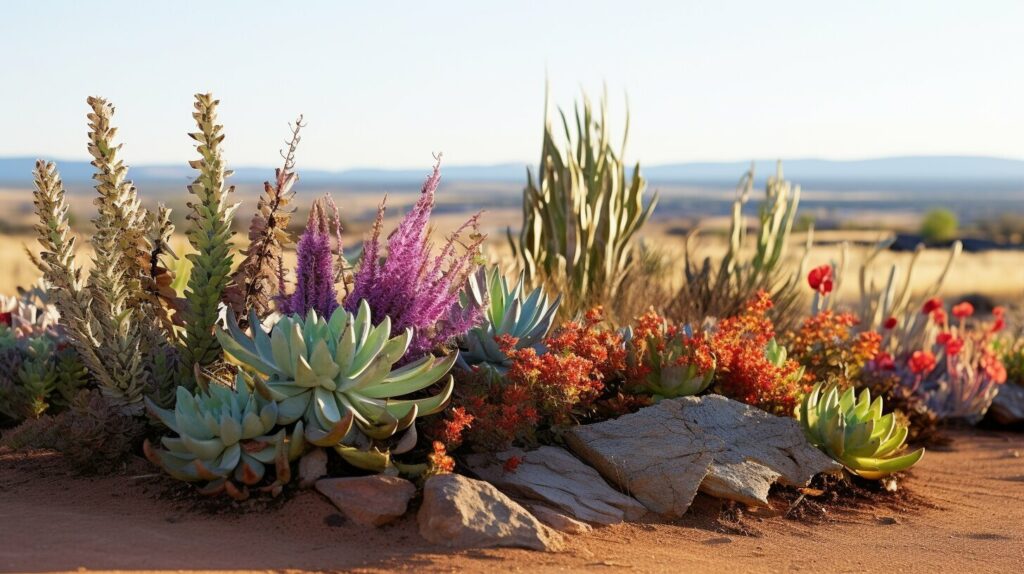
By selecting drought-tolerant plants that are well-suited to your region, you can create a beautiful and sustainable landscape that conserves water and reduces maintenance costs.
Designing a Beautiful Landscape with Sustainable Elements
Creating a sustainable landscape goes beyond just choosing drought-tolerant plants. By incorporating sustainable elements into your design, you can enhance the beauty and functionality of your garden while contributing to a healthier environment. Here are some key principles of sustainable landscape design:
Use Native Plants
Native plants are adapted to local climate, soil, and pests, making them more resilient and easier to maintain. They also provide habitat and food for native wildlife, helping to improve biodiversity in your garden. Incorporating native plants into your landscape design can be as simple as replacing some of your existing lawn with a wildflower meadow or planting a few native trees.
Create Rain Gardens
Rain gardens are designed to capture and utilize rainwater runoff from your roof or driveway. They are typically planted with native plants that can handle periods of both drought and heavy rain. Not only do rain gardens conserve water, but they also help to filter pollutants and reduce erosion. Consider installing a rain garden as a focal point in your landscape design.
Use Permeable Surfaces
Permeable surfaces, such as gravel or permeable pavers, allow water to infiltrate into the soil, reducing runoff and erosion. They are also less heat absorbent than traditional concrete or asphalt surfaces, helping to reduce the urban heat island effect. Consider incorporating permeable surfaces into your hardscape design, such as a gravel pathway or patio.
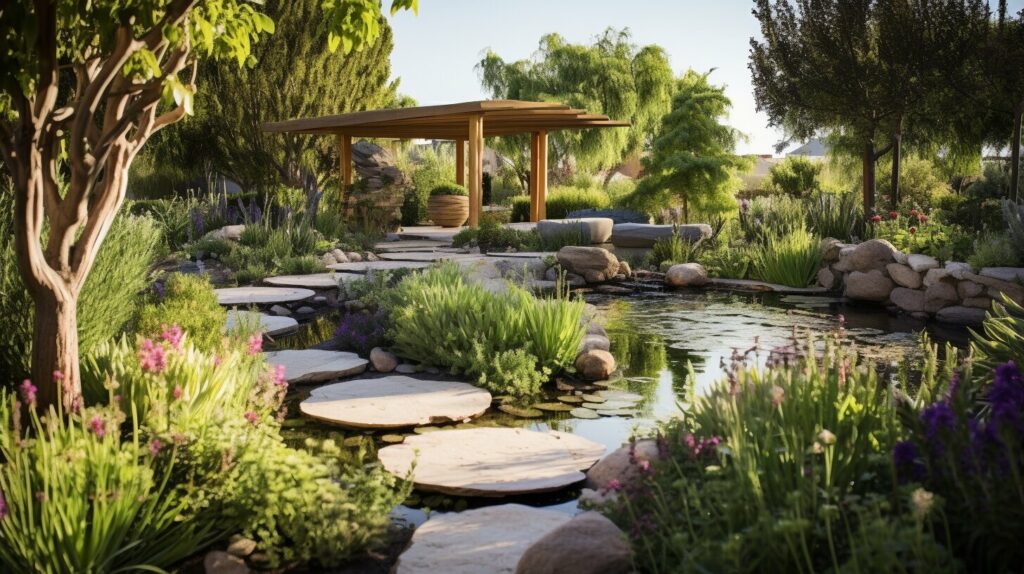
By using native plants, creating rain gardens, and incorporating permeable surfaces, you can design a beautiful and sustainable landscape that conserves water, reduces runoff, and improves biodiversity. These elements can also help to enhance the visual appeal of your garden, creating a natural and inviting space that you can enjoy for years to come.
Water Conservation Techniques for Sustainable Landscaping
When it comes to sustainable landscaping, conserving water is a top priority. By implementing water conservation techniques, you can reduce your water usage and save money on your utility bills. Here are some effective techniques for creating a water-efficient garden:
- Drip irrigation: This technique involves delivering water directly to the roots of plants, minimizing evaporation and runoff. Consider installing a drip irrigation system to save up to 70% of water compared to traditional sprinkler systems.
- Mulching: Apply a layer of organic mulch around the base of your plants to retain moisture in the soil and suppress weeds. This can reduce your water usage by up to 50%.
- Proper soil preparation: Improve the water-holding capacity of your soil by adding organic matter like compost or planting cover crops. This will help your plants retain water and reduce the need for frequent watering.
Using these techniques can significantly reduce your water usage while keeping your garden healthy and beautiful.
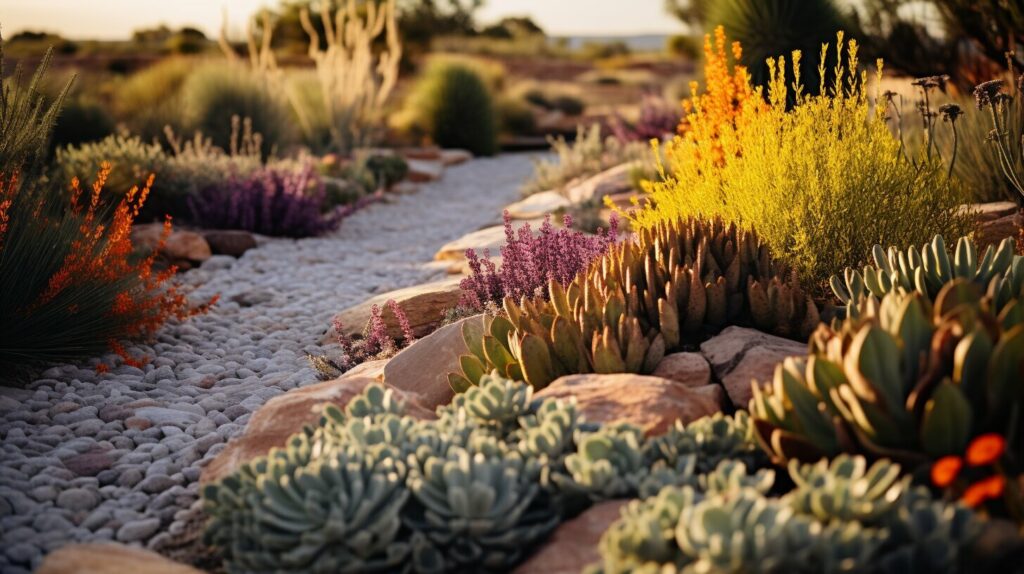
“By implementing water conservation techniques, you can reduce your water usage and save money on your utility bills.”
Maintaining Your Sustainable Landscape
Congratulations! By following the tips and techniques for sustainable landscape design, you have created a beautiful and eco-friendly garden that conserves water and supports local biodiversity. To ensure that your landscape continues to thrive, it is essential to maintain it properly.
First, proper watering is critical for a sustainable landscape. Be sure to water your plants deeply but infrequently, allowing the soil to dry out slightly between watering sessions. Use a drip irrigation system or a soaker hose instead of a sprinkler system to maximize water efficiency.
Pruning is also an important aspect of landscape maintenance. Regular pruning promotes healthy plant growth and keeps shrubs and trees from becoming overgrown. Use sharp pruning shears to make clean cuts, and avoid over-pruning, which can damage the plant.
Pest control is another critical component of landscape maintenance. Keep an eye out for common garden pests, such as aphids and spider mites, and take action promptly to prevent them from spreading. Use natural pest control methods, like introducing beneficial insects or using neem oil, to minimize the use of harmful chemicals.
Finally, be sure to mulch your garden regularly to conserve water and suppress weed growth. Mulch helps to retain moisture in the soil, reducing the frequency of watering sessions. Use organic materials like shredded bark, straw, or leaves for the best results.

Remember, maintaining a sustainable landscape requires ongoing care and attention. Follow these guidelines to keep your garden looking beautiful and healthy for years to come.
Benefits of Sustainable Landscaping
Choosing drought-tolerant plants and implementing sustainable landscaping practices not only benefits the environment but also has numerous advantages for you and your community. Here are some benefits of sustainable landscaping:
- Water conservation: By using drought-tolerant plants and efficient irrigation techniques, you can significantly reduce your water consumption and associated costs.
- Reduced maintenance: Sustainable landscaping requires less maintenance than traditional landscapes, as native plants are better adapted to the local climate and require minimal care.
- Improved biodiversity: Sustainable landscapes provide critical habitat for native wildlife and help increase biodiversity in urban areas.
- Increased property value: A beautiful, sustainable landscape can significantly increase your property’s value and appeal to potential buyers.
By adopting sustainable landscaping practices, you are not only making a positive impact on the environment but also creating a beautiful and functional outdoor space that can benefit you and your community.
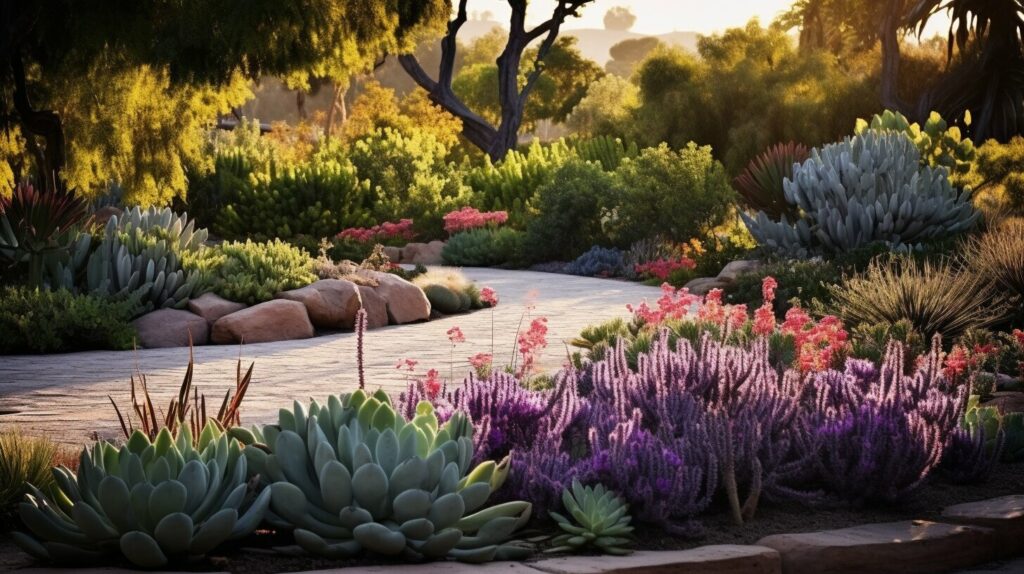
Overcoming Challenges in Sustainable Landscaping
Designing and maintaining a sustainable landscape can come with its own set of challenges, but with the right strategies and solutions, you can overcome them effectively. Here are some common challenges you might face and how to tackle them:
Plant Selection
Choosing the right plants that thrive in low-water conditions can be a daunting task, especially if you live in an area with extreme weather conditions. Research different types of drought-tolerant plants that are suitable for your region and climate, and consider factors such as soil type, sun exposure, and water availability. You can also consult with a local nursery or landscaping professional for guidance.
Soil Preparation
Proper soil preparation is crucial for a sustainable landscape, but it can be time-consuming and labor-intensive. Before planting, test your soil to determine its nutrient content and pH level. If necessary, amend your soil with organic matter such as compost or manure to improve its texture and fertility. This will help your plants to establish strong roots and absorb water more efficiently.
Extreme Weather Conditions
Extreme weather conditions such as drought, heatwaves, or heavy rains can pose a threat to your sustainable landscape. To mitigate these risks, incorporate elements such as rain gardens, permeable surfaces, and mulch into your landscape design. These elements can help to absorb excess water during heavy rains and retain moisture during dry periods. You can also consider installing a drip irrigation system to provide consistent watering while minimizing water waste.
By overcoming these challenges, you can create a sustainable landscape that not only conserves water and reduces costs but also enhances the beauty and functionality of your garden.
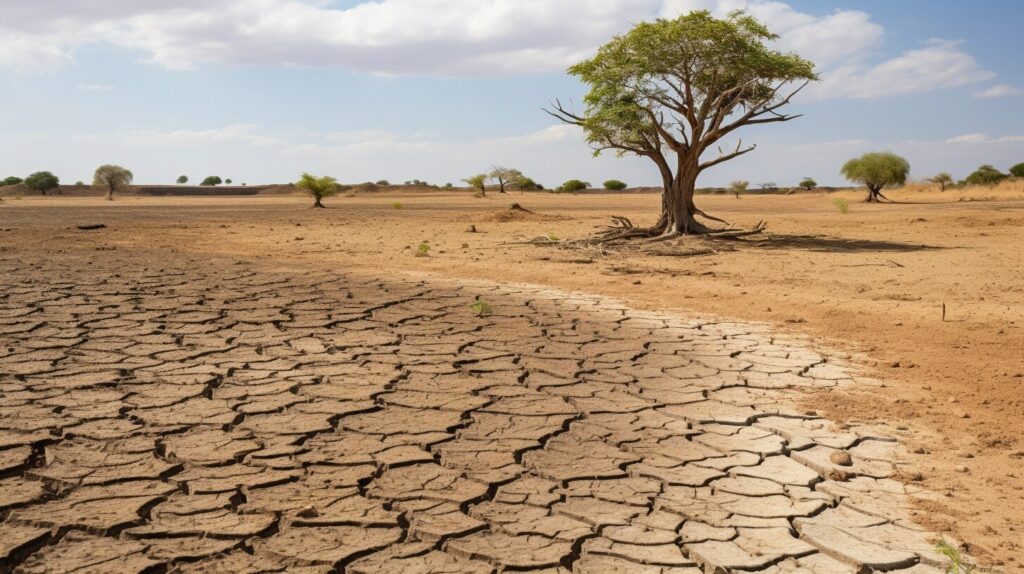
Engaging in Community Sustainability Efforts
Creating a sustainable landscape is not only beneficial for your home but also for the environment. By engaging in community sustainability efforts, you can make an even greater impact and inspire others to follow in your footsteps.
One way to get involved is by joining a local garden club or sustainability group. These organizations often host events and workshops that educate members on sustainable practices and provide opportunities to volunteer in the community. You can also connect with other gardeners in your area and share tips and resources for creating eco-friendly landscapes.
Another way to contribute to sustainability efforts is by volunteering for environmental projects. This can include planting trees, cleaning up parks and waterways, and advocating for policy changes that support sustainable practices. Volunteering not only benefits the environment, but also gives you a chance to connect with like-minded individuals and make a positive impact in your community.
Finally, you can contribute to sustainability efforts by spreading awareness and educating others about the benefits of sustainable landscaping. Share your knowledge and experiences with friends and family, and encourage them to make small changes in their own landscapes. Together, we can create a more sustainable future for our planet.
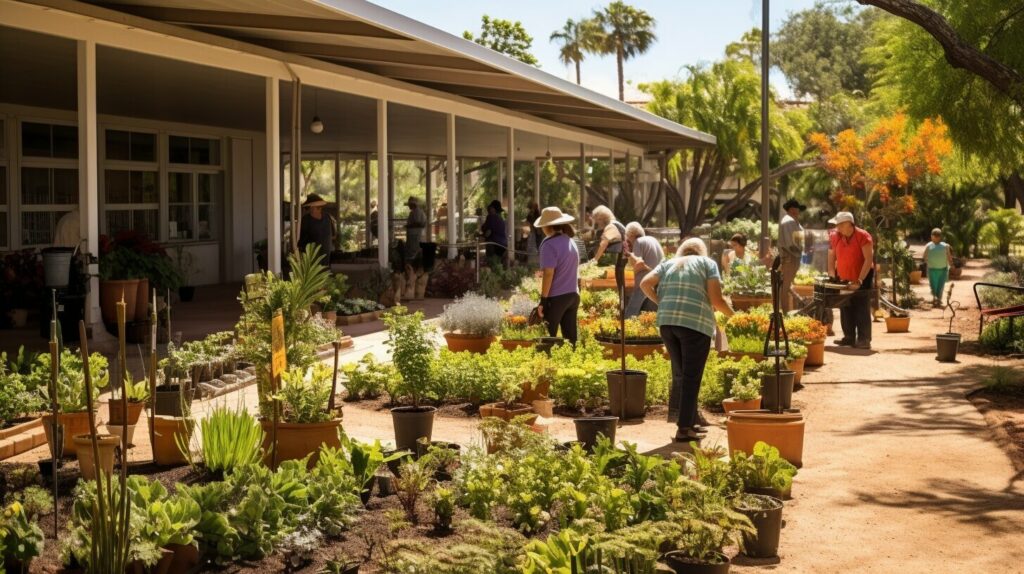
Sustainable Landscaping with Drought-Tolerant Plants: Conclusion
Congratulations! You’ve learned so much about sustainable landscaping and how to create your own water-efficient garden using drought-tolerant plants. By implementing the tips and techniques in this article, you’ll be able to conserve water, reduce maintenance costs, and enhance the biodiversity of your landscape.
Remember, sustainable landscaping is not just about creating a beautiful garden, it’s also about promoting a healthier environment for future generations. By choosing plants that thrive in low-water conditions and utilizing water conservation techniques, you’ll be doing your part to conserve one of our planet’s most precious resources.
Take Action Today!
Don’t wait any longer to start your sustainable landscaping journey. Begin by researching the drought-tolerant plants that are best suited for your region and incorporating water-efficient design strategies into your landscape plan. Remember to maintain your sustainable garden regularly to keep it healthy and thriving.
Finally, don’t forget to get involved in community sustainability efforts. You can join a local garden club or volunteer for an environmental project to make a positive impact in your neighborhood. Together, we can create a better future for ourselves and the planet.
Thank you for reading this article. We hope it has inspired you to take action and create your own eco-friendly garden!
FAQ
Q: What is sustainable landscaping?
A: Sustainable landscaping is an approach to designing and maintaining outdoor spaces that focuses on reducing water usage, minimizing waste, and promoting environmental conservation.
Q: Why should I use drought-tolerant plants in my landscape?
A: Drought-tolerant plants are able to thrive with minimal water, making them ideal for water conservation efforts. By using these plants, you can reduce your water usage and save money on irrigation.
Q: What are some tips for designing a water-efficient garden?
A: To create a water-efficient garden, consider incorporating xeriscaping techniques, such as using native plants, installing efficient irrigation systems, and utilizing mulch to retain moisture in the soil.
Q: How do I choose the right drought-tolerant plants for my region?
A: When selecting drought-tolerant plants, it’s important to consider your region’s climate and soil conditions. Look for plants that are native to your area or adapted to similar conditions to ensure their survival.
Q: What are some sustainable elements I can include in my landscape design?
A: You can incorporate sustainable elements into your landscape design by using native plants, creating rain gardens to capture and filter rainwater, and using permeable surfaces to reduce runoff and promote groundwater recharge.
Q: What are some water conservation techniques I can use in my landscape?
A: Some water conservation techniques include using drip irrigation systems to deliver water directly to plant roots, applying mulch to retain moisture, and preparing the soil properly to improve water absorption.
Q: How do I maintain a sustainable landscape?
A: To maintain a sustainable landscape, it’s important to follow proper watering schedules, use pruning techniques that promote plant health and shape, and employ environmentally-friendly pest control methods.
Q: What are the benefits of sustainable landscaping?
A: Sustainable landscaping offers numerous benefits, including water conservation, reduced maintenance, increased biodiversity, and improved property value. It also contributes to a healthier environment and supports local ecosystems.
Q: What challenges might I encounter in sustainable landscaping?
A: Some common challenges in sustainable landscaping include selecting the right plants for specific conditions, preparing the soil for optimal plant growth, and dealing with extreme weather conditions. By planning ahead and seeking expert advice, these challenges can be overcome.
Q: How can I get involved in community sustainability efforts?
A: You can get involved in community sustainability efforts by joining local garden clubs, volunteering for environmental projects, and participating in community initiatives focused on conservation and ecological restoration.
